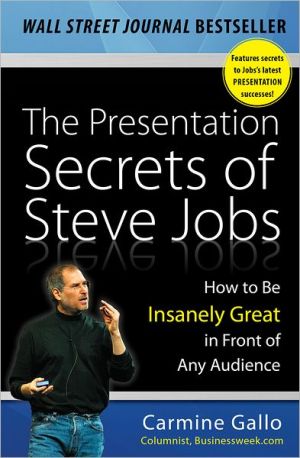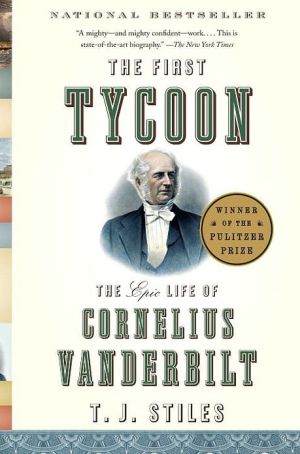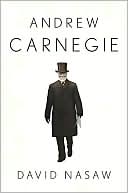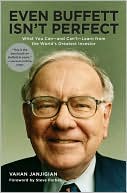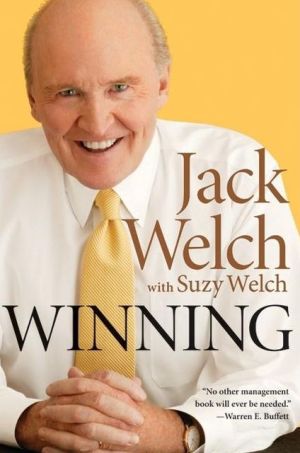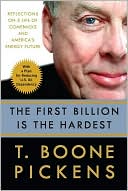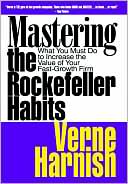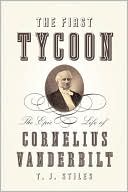The Presentation Secrets of Steve Jobs: How to Be Insanely Great in Front of Any Audience
The Wall Street Journal Bestseller!\ Updated to include Steve Jobs's iPad and iPad2 launch presentations\ “The Presentation Secrets of Steve Jobs reveals the operating system behind any great presentation and provides you with a quick-start guide to design your own passionate interfaces with your audiences.”\ —Cliff Atkinson, author of Beyond Bullet Points and The Activist Audience\ Former Apple CEO Steve Jobs’s wildly popular presentations have set a new global gold standard—and now this...
Search in google:
“The Presentation Secrets of Steve Jobs reveals the operating system behindany great presentation and provides you with a quick-start guide to designyour ownpassionate interfaces with your audiences.”—Cliff Atkinson, author of Beyond Bullet Points and The Activist AudienceApple CEO Steve Jobs’s wildly popular presentations have set a new globalgold standard—and now this step-by-step guide shows you exactly how to usehiscrowd-pleasing techniques in your own presentations.The Presentation Secrets of Steve Jobs is as close as you’ll ever get tohaving the master presenter himself speak directly in your ear.Communications expert Carmine Gallo has studied and analyzed the very bestof Jobs’s performances, offering point-by-point examples, tried-and-truetechniques, and proven presentation secrets that work every time. With thisrevolutionary approach, you’ll be surprised at how easy it is to sell yourideas, share your enthusiasm, and wow your audience the Steve Jobs way.“No other leader captures an audience like Steve Jobs does and, like no other book, The Presentation Secrets of Steve Jobs captures the formula Steve uses to enthrall audiences.” —Rob Enderle, The Enderle Group“Now you can learn from the best there is—both Jobs and Gallo. No matter whether you are a novice presenter or a professional speaker like me, you will read and reread this book with the same enthusiasm that people bring to their iPods."—David Meerman Scott, bestselling author of The New Rules of Marketing & PR and World Wide RaveCarmine Gallo writes a bi-weekly columnfor Businessweek.com and has been a featured contributorto several other major websites including MSNBC,Military.com, Always On, AOL and Yahoo Finance. Gallo personally coaches leading executives for keynote speeches,media interviews, product launches, and book tours.
The Presentation Secrets of Steve Jobs\ How to Be Insanely Great in Front of Any Audience \ \ By Carmine Gallo \ McGraw-Hill\ Copyright © 2010 Carmine Gallo\ All right reserved.\ ISBN: 978-0-07-163675-9 \ \ \ Chapter One\ SCENE 1\ Plan in Analog\ Marketing is really theater. It's like staging a performance.\ —JOHN SCULLEY\ Steve Jobs has built a reputation in the digital world of bits and bytes, but he creates stories in the very old-world tradition of pen and paper. His presentations are theatrical events intended to generate maximum publicity, buzz, and awe. They contain all of the elements of great plays or movies: conflict, resolution, villains, and heroes. And, in line with all great movie directors, Jobs storyboards the plot before picking up a "camera (i.e., opening the presentation software). It's marketing theater unlike any other.\ Jobs is closely involved in every detail of a presentation: writing descriptive taglines, creating slides, practicing demos, and making sure the lighting is just right. Jobs takes nothing for granted. He does what most top presentation designers recommend: he starts on paper. "There's just something about paper and pen and sketching out rough ideas in the 'analog world' in the early stages that seems to lead to more clarity and better, more creative results when we finally get down to representing our ideas digitally," writes Garr Reynolds in Presentation Zen.\ Design experts, including those who create presentations for Apple, recommend that presenters spend the majority of their time thinking, sketching, and scripting. Nancy Duarte is the genius behind Al Gore's An Inconvenient Truth. Duarte suggests that a presenter spend up to ninety hours to create an hour-long presentation that contains thirty slides. However, only one-third of that time should be dedicated to building the slides, says Duarte. The first twenty-seven hours are dedicated to researching the topic, collecting input from experts, organizing ideas, collaborating with colleagues, and sketching the structure of the story.\ Bullets Kill\ Think about what happens when you open PowerPoint. A blank-format slide appears that contains space for words—a title and subtitle. This presents a problem. There are very few words in a Steve Jobs presentation. Now think about the first thing you see in the drop-down menu under Format: Bullets & Numbering. This leads to the second problem. There are no bullet points in a Steve Jobs presentation. The software itself forces you to create a template that represents the exact opposite of what you need to speak like Steve! In fact, as you will learn in later scenes, texts and bullets are the least effective way to deliver information intended to be recalled and acted upon. Save your bullet points for grocery lists.\ Visually engaging presentations will inspire your audience. And yes, they require a bit of work, especially in the planning phase. As a communications coach, I work with CEOs and other top executives on their media, presentation, and public speaking skills. One of my clients, a start-up entrepreneur, had spent sixty straight days in Bentonville, Arkansas, to score an appointment with Wal-Mart. His technology intrigued company executives, who agreed to a beta test, a trial run. Wal-Mart asked him to present the information to a group of advertisers and top executives. I met with my client over a period of days at the offices of the Silicon Valley venture capital firm that invested in his company. For the first day, we did nothing but sketch the story. No computer and no PowerPoint—just pen and paper (whiteboard, in this case). Eventually we turned the sketches into slide ideas. We needed only five slides for a fifteen-minute presentation. Creating the slides did not take as much time as developing the story. Once we wrote the narrative, designing the slides was easy. Remember, it's the story, not the slides, that will capture the imagination of your audience.\ The Napkin Test\ A picture is the most powerful method for conveying an idea. Instead of booting up your computer, take out a napkin. Some of the most successful business ideas have been sketched on the back of a napkin. One could argue that the napkin has been more important to the world of business ideas than PowerPoint. I used to think that "napkin stories" were just that—stories, from the imagination of journalists. That is until I met Richard Tait, the founder of Cranium. I prepared him for an interview on CNBC. He told me that during a cross-country flight from New York to Seattle, he took out a small cocktail napkin and sketched the idea of a board game in which everyone had a chance to excel in at least one category, a game that would give everyone a chance to shine. Cranium became a worldwide sensation and was later purchased by Hasbro. The original concept was simple enough to write on a tiny airline napkin.\ One of the most famous corporate napkin stories involves Southwest Airlines. A lawyer at the time, Herb Kelleher met with one of his clients, Rollin King, at the St. Anthony's Club, in San Antonio. King owned a small charter airline. He wanted to start a low-cost commuter airline that avoided the major hubs and instead served Dallas, Houston, and San Antonio. King sketched three circles, wrote the names of the cities inside, and connected the three—a strikingly simple vision. Kelleher understood immediately. Kelleher signed on as legal counsel (he later became CEO), and the two men founded Southwest Airlines in 1967. King and Kelleher would go on to reinvent airline travel in the United States and build a corporate culture that would earn Southwest's place among the most admired companies in the world. Never underestimate the power of a vision so simple that it can fit on a napkin!\ The Story Takes Center Stage\ In Beyond Bullet Points, Cliff Atkinson stresses, "The single most important thing you can do to dramatically improve your presentations is to have a story to tell before you work on your PowerPoint file." Atkinson advocates a three-step storyboard approach to creating presentations:\ Writing -> Sketching -> Producing\ Only after writing—scripting—the scenes does he advocate thinking visually about how the slides will look. "To write a script, you need to momentarily set aside PowerPoint design issues like fonts, colors, backgrounds, and slide transitions. Although it might sound counterintuitive, when you write a script first, you actually expand your visual possibilities, because writing defines your purpose before you start designing. A script unlocks the undiscovered power of PowerPoint as a visual storytelling tool in ways that might surprise and delight you and your audiences." With a completed script in hand, you'll be ready to sketch and "produce" the experience. The script, however, must come first.\ Nine Elements of Great Presentations\ Persuasive presentation scripts contain nine common elements. Think about incorporating each of these components before you open the presentation program, whether you work in PowerPoint, Keynote, or any other design software. Some of these concepts will be explored in more detail later, but for now keep them in mind as you develop your ideas.\ HEADLINE\ What is the one big idea you want to leave with your audience? It should be short (140 characters or less), memorable, and written in the subject-verb-object sequence. When Steve Jobs unveiled the iPhone, he exclaimed, "Today Apple reinvents the phone!" That's a headline. Headlines grab the attention of your audience and give people a reason to listen. Read USA Today for ideas. Here are some examples from America's most popular daily newspaper:\ >> "Apple's Skinny MacBook Is Fat with Features"\ >> "Apple Unleashes Leopard Operating System"\ >> "Apple Shrinks iPod"\ PASSION STATEMENT\ Aristotle, the father of public speaking, believed that successful speakers must have "pathos," or passion for their subject. Very few communicators express a sense of excitement about their topic. Steve Jobs exudes an almost giddy enthusiasm every time he presents. Former employees and even some journalists have claimed that they found his energy and enthusiasm completely mesmerizing. Spend a few minutes developing a passion statement by filling in the following sentence: "I'm excited about this product [company, initiative, feature, etc.] because it ______________________." Once you have identified the passion statement, don't be bashful—share it.\ THREE KEY MESSAGES\ Now that you have decided on your headline and passion statement, write out the three messages you want your audience to receive. They should be easily recalled without the necessity of looking at notes. Although Scene 5 is dedicated to this subject, for now keep in mind that your listeners can recall only three or four points in short-term memory. Each of the key messages will be followed by supporting points.\ METAPHORS AND ANALOGIES\ As you develop key messages and supporting points, decide on which rhetorical devices will make your narrative more engaging. According to Aristotle, metaphor is "the most important thing by far." A metaphor—a word or phrase that denotes one thing and is used to designate another for purposes of comparison—is a persuasive tool in the best marketing, advertising, and public relations campaigns. Jobs uses metaphors in conversations and presentations. In one famous interview, Jobs said, "What a computer is to me is the most remarkable tool that we have ever come up with. It's the equivalent of a bicycle for our minds."\ Sales professionals are fond of sports metaphors: "We're all playing for the same team"; "This isn't a scrimmage; it's for real"; or "We're batting a thousand; let's keep it up." While sports metaphors work fine, challenge yourself to break away from what your audience expects. I came across an interesting metaphor for a new antivirus suite of applications from Kaspersky. The company ran full-page ads (the one I saw was in USA Today) that showed a dejected medieval soldier in a full suit of armor walking away, with his back toward the reader. The headline read, "Don't be so sad. You were very good once upon a time." The metaphor compared today's Internet security technologies (Kaspersky's competitors) to slow, cumbersome medieval armor, which of course is no match for today's military technology. The company extended the metaphor to the website with an image of a suit of armor and the same tagline. The metaphor was consistent throughout the company's marketing material.\ Analogies are close cousins of metaphors and also are very effective. An analogy is a comparison between two different things in order to highlight some area of similarity. Analogies help us understand concepts that might be foreign to us. "The microprocessor is the brain of your computer" is an analogy that works well for companies such as Intel. In many ways, the chip serves the same function in the computer as a brain serves in a human. The chip and the brain are two different things with like features. This particular analogy is so useful that it is widely picked up by the media. When you find a strong analogy that works, stick with it and make it consistent across your presentations, website, and marketing material. Jobs likes to have fun with analogies, especially if they can be applied to Microsoft. During an interview with the Wall Street Journal's Walt Mossberg, Jobs pointed out that many people say iTunes is their favorite application for Windows. "It's like giving a glass of ice water to someone in hell!"\ DEMONSTRATIONS\ Jobs shares the spotlight with employees, partners, and products. Demos make up a large part of his presentations. When Jobs unveiled a new version of the OS X operating system, code-named Leopard, at Apple's Worldwide Developers Conference (commonly abbreviated WWDC, the annual conference is an Apple event to showcase new software and technologies) in June 2007, he said Leopard had three hundred new features. He chose ten to discuss and demonstrate, including Time Machine (automated backup), Boot Camp (runs Windows XP and Vista on Mac), and Stacks (file organization). Instead of simply listing the features on a slide and explaining them, he sat down and showed the audience how they worked. He also chose the features he wanted the press to highlight. Why leave it to the media to decide which of three hundred new features were the most compelling? He would tell them.\ Does your product lend itself to a demonstration? If so, script it into the presentation. Your audience wants to see, touch, and experience your product or service. Bring it to life.\ I worked with Goldman Sachs investors to prepare the CEO of a Silicon Valley semiconductor start-up that was about to go public. The company shrinks chips that create audio sound for mobile computers. As we were planning the investor presentation, the CEO pulled out a chip the size of a fingernail and said, "You wouldn't believe the sound that this generates. Listen to this." He turned up the volume on his laptop and played music that impressed those of us who were in the room. It was a no-brainer to use the same demonstration (with a more dramatic buildup) when the executive pitched the company to investors. The IPO went on to become a huge success. An investor who had underwritten the company later called me and said, "I don't know what you did, but the CEO was a hit." I didn't have the heart to say that I stole the idea from the Steve Jobs playbook.\ PARTNERS\ Jobs shares the stage with key partners as well as his products. In September 2005, Jobs announced that all of Madonna's albums would be available on iTunes. The pop star herself suddenly appeared via webcam and joked with Jobs that she had tried to hold out as long as possible but got tired of not being able to download her own songs. Whether it's an artist or an industry partner like the CEOs of Intel, Fox, or Sony, Jobs often shares the stage with people who contribute to Apple's success.\ CUSTOMER EVIDENCE AND THIRD-PARTY ENDORSEMENTS\ Offering "customer evidence" or testimonials is an important part of the selling cycle. Few customers want to be pioneers, especially when budgets are tight. Just as recruiters ask for references, your customers want to hear success stories. This is especially critical for small companies. Your sales and marketing collateral might look great in that glossy four-color brochure, but it will be met with a healthy degree of skepticism. The number one influencer is word of mouth. Successful product launches usually have several customers who were involved in the beta and who can vouch for the product. Incorporate customer evidence into your pitch. Including a quote is simple enough, but try going one step further by recording a short testimonial and embedding the video on your site and in your presentation. Even better, invite a customer to join you in person (or via webcam) at a presentation or an important sales meeting.\ Do you have third-party reviews of your product? Always use third-party endorsements when available. Word of mouth is one of the most effective marketing tools available, and when your customers see an endorsement from a publication or an individual they respect, it will make them feel more comfortable about their purchasing decisions.\ VIDEO CLIPS\ Very few presenters incorporate video into their presentations. Jobs plays video clips very often. Sometimes he shows video of employees talking about how much they enjoyed working on a product. Jobs is also fond of showing Apple's most recent television ads. He does so in nearly every major new product announcement and has been doing so since the launch of the famous Macintosh 1984 Super Bowl ad. He's been known to enjoy some ads so much that he showed them twice. Near the end of his presentation at Apple's WWDC in June 2008, Jobs announced the new iPhone 3G, which connects to higher-speed data networks and costs less than the iPhone that was currently on the market. He showed a television ad with the tagline "It's finally here. The first phone to beat the iPhone." When the thirty-second spot ended, a beaming Jobs said, "Isn't that nice? Want to see it again? Let's roll that again. I love this ad."\ Including video clips in your presentation will help you stand out. You can show ads, employee testimonials, scenes of the product or of people using the product, and even customer endorsements. What could be more persuasive than hearing directly from a satisfied customer—if not in person, then through a short video clip embedded in your presentation? You can easily encode video into digital formats such as MPEG 1, Windows Media, or Quicktime files, all of which will work for most presentations. Keep in mind that the average viewed clip on YouTube is 2.5 minutes. Our attention spans are shrinking, and video, while providing a great way to keep the audience engaged, can be overused if left to run too long. Use video clips in your presentations, but avoid clips that run much longer than two to three minutes.\ (Continues...)\ \ \ \ \ Excerpted from The Presentation Secrets of Steve Jobs by Carmine Gallo Copyright © 2010 by Carmine Gallo. Excerpted by permission of McGraw-Hill. All rights reserved. No part of this excerpt may be reproduced or reprinted without permission in writing from the publisher.\ Excerpts are provided by Dial-A-Book Inc. solely for the personal use of visitors to this web site. \ \
Acknowledgments viiPrologue:How to be Insanely Great in Front of Any Audience ixAct 1 Create the History 1Scene 1 Plan in Analog 3Scene 2 Answer the One Question That Matters Most 15Scene 3 Develop a Messianic Sense of Purpose 27Scene 4 Create Twitter-Like Headlines 39Scene 5 Draw a Road Map 49Scene 6 Introduce the Antagonist 63Scene 7 Reveal the Conquering Hero 75Intermission 1 Obey the Ten-Minute Rule 83Act 2 Deliver the Experience 85Scene 8 Channel Their Inner Zen 87Scene 9 Dress Up Your Numbers 105Scene 10 Use "Amazingly Zippy" Words 113Scene 11 Share the Stage 127Scene 12 Stage Your Presentation with Props 137Scene 13 Reveal a "Holy Shit" Moment 151Intermission 2 Schiller Learns from the Best 161Act 3 Refine and Rehearse 165Scene 14 Master Stage Presence 167Scene 15 Make it Look Effortless 179Scene 16 Wear the Appropriate Constume 195Scene 17 Toss the Script 199Scene 18 Have Fun 207Encore:One More Thing 215Notes 219Index 233
